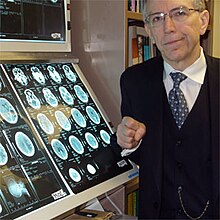
Back مایکل پرسینقر AZB Michael Persinger German Michael Persinger Spanish مایکل پرسینگر Persian Michael Persinger French Michael Persinger Italian Michael Persinger SIMPLE
This article has multiple issues. Please help improve it or discuss these issues on the talk page. (Learn how and when to remove these template messages)
|
Michael Persinger | |
|---|---|
 Persinger in 2010 | |
| Born | June 26, 1945 Jacksonville, Florida, U.S. |
| Died | August 14, 2018 (aged 73) Sudbury, Ontario, Canada |
| Nationality | Canadian |
| Citizenship | Canadian American |
| Alma mater | University of Wisconsin University of Tennessee University of Manitoba |
| Known for | Director of Laurentian University's Consciousness Research Laboratory. Notable for his work in the field of neurotheology. |
| Awards | LIFT (Leader in Faculty Teaching), 2007 TVO (Ontario) Best Lecturer 2007 |
| Scientific career | |
| Fields | Neurotheology, Neuroscience, Parapsychology, Biophysics, Geophysics, Epilepsy |
| Institutions | Laurentian University |
Michael A. Persinger (June 26, 1945 – August 14, 2018) was an American-Canadian professor of psychology at Laurentian University, a position he had held from 1971 until his death in 2018.[1] His best-known hypotheses include the temporal lobes of the human brain as the central correlate for mystical experiences, subtle changes in geomagnetic activity as mediators of parapsychological phenomena, the tectonic strain within the Earth's crust as the source of luminous phenomena attributed to unidentified aerial objects, and the importance of specific quantifications for energy (10−20 Joules), photon flux density (picoWatt per meter squared), and small shifts in magnetic field intensities (picoTesla to nanoTesla range) for integrating cellular activity as well as human thought with universal phenomena.[2][3][4][5][6][7][8]
Persinger's experimental work on paranormal experiences has received widespread media coverage[9][10][11][12] but has also been widely criticised.[13][14][15][16][17] His major research themes have included electromagnetic field effects upon biological organisms, epilepsy, temporal lobe functions, properties of biophotons, geophysical-human interactions, physical cosmology, and the quantifiable examination of what Persinger terms "low-probability phenomena" such as time travel, parallel universes, and the universe as a simulation.[18] He has published over 500 technical articles in scientific journals (many in predatory journals), more than a dozen chapters in various books, and seven of his own books.[19] His book with Ghislaine Lafreniere, entitled Space-Time Transients and Unusual Events (1977), documents the search for patterns in phenomena that are not compatible with current scientific paradigms.[18]
He argued that all phenomena including consciousness, spiritual experiences, and "paranormal events" can be explained by universal physical mechanisms and can be verified using the scientific method.[1] [citation needed] Further, he has claimed that the structure and function of the brain determine the boundaries of human perception of the universe, and that shared quantitative values connect local phenomena with fundamental properties of the cosmos.[20]
- ^ a b Nik TheSaint (2012-12-09), Michael Persinger - Psychotropic drugs and nature of reality, archived from the original on 2021-12-12, retrieved 2017-06-18
- ^ Persinger, Michael A. (1987). Neuropsychological bases of God beliefs. New York: Prager Publishers. ISBN 978-0275926489.
- ^ Persinger, Michael A. (Fall 2001). "The Neuropsychiatry of Paranormal Experiences" (PDF). Journal of Neuropsychiatry and Clinical Neurosciences. 13 (4): 515–524. doi:10.1176/jnp.13.4.515. PMID 11748322. S2CID 14954419. Archived from the original (PDF) on 2018-01-30.
- ^ Persinger, Michael A. (1983). "Religious and Mystical Experiences as Artifacts of Temporal Lobe Function: A General Hypothesis". Perceptual and Motor Skills. 57 (3_suppl): 1255–1262. doi:10.2466/pms.1983.57.3f.1255. PMID 6664802. S2CID 486935.
- ^ Persinger, Michael A. (Summer 2010). "10-20 Joules as a Neuromolecular Quantum in Medicinal Chemistry: An Alternative Approach to Myriad Molecular Pathways?". Current Medicinal Chemistry. 17 (27): 3094–3098. doi:10.2174/092986710791959701. PMID 20629623.
- ^ Persinger, Michael A. (2015). "Inverse relationship between photon flux densities and nanotesla magnetic fields over cell aggregates: Quantitative evidence for energetic conservation". FEBS Open Bio. 5: 413–418. doi:10.1016/j.fob.2015.04.015. PMC 4436372. PMID 26005634.
- ^ Persinger, Michael (2007). "A theory of neurophysics ad quantum neuroscience: implications for brain function and the limits of consciousness". Int. J. Neurosci. 117 (2): 117–157. doi:10.1080/00207450500535784. PMID 17365106. S2CID 27517078.
- ^ Dotta, Blake (2011). "Photon emissions from human brain and cell culture exposed to distally rotating magnetic fields shared by separate light-stimulated brains and cells". Brain Research. 1388: 77–88. doi:10.1016/j.brainres.2011.03.001. PMID 21396353. S2CID 12565159.
- ^ Cite error: The named reference
Telegraphwas invoked but never defined (see the help page). - ^ Cite error: The named reference
NationalPostwas invoked but never defined (see the help page). - ^ Cite error: The named reference
Wiredwas invoked but never defined (see the help page). - ^ Cite error: The named reference
BBCwas invoked but never defined (see the help page). - ^ Cite error: The named reference
Wisemanwas invoked but never defined (see the help page). - ^ Cite error: The named reference
AaenStockdalewas invoked but never defined (see the help page). - ^ Cite error: The named reference
Granqvistwas invoked but never defined (see the help page). - ^ Cite error: The named reference
Larssonwas invoked but never defined (see the help page). - ^ Cite error: The named reference
NatureNewswas invoked but never defined (see the help page). - ^ a b Persinger, Michael A. (1977). Space-time transients and unusual events. Chicago: Nelson-Hall. p. 231. ISBN 978-0-88229-334-9.
- ^ "Persinger CV". neurocogconsultants.app.box.com. Retrieved 2017-06-17.
- ^ Persinger, Michael A. (1999). "On the nature of space-time in the observation of physical events in science" (PDF). Perceptual and Motor Skills. 88 (3_suppl): 1210–1216. doi:10.2466/pms.1999.88.3c.1210. PMID 10485103. S2CID 23391338.
© MMXXIII Rich X Search. We shall prevail. All rights reserved. Rich X Search